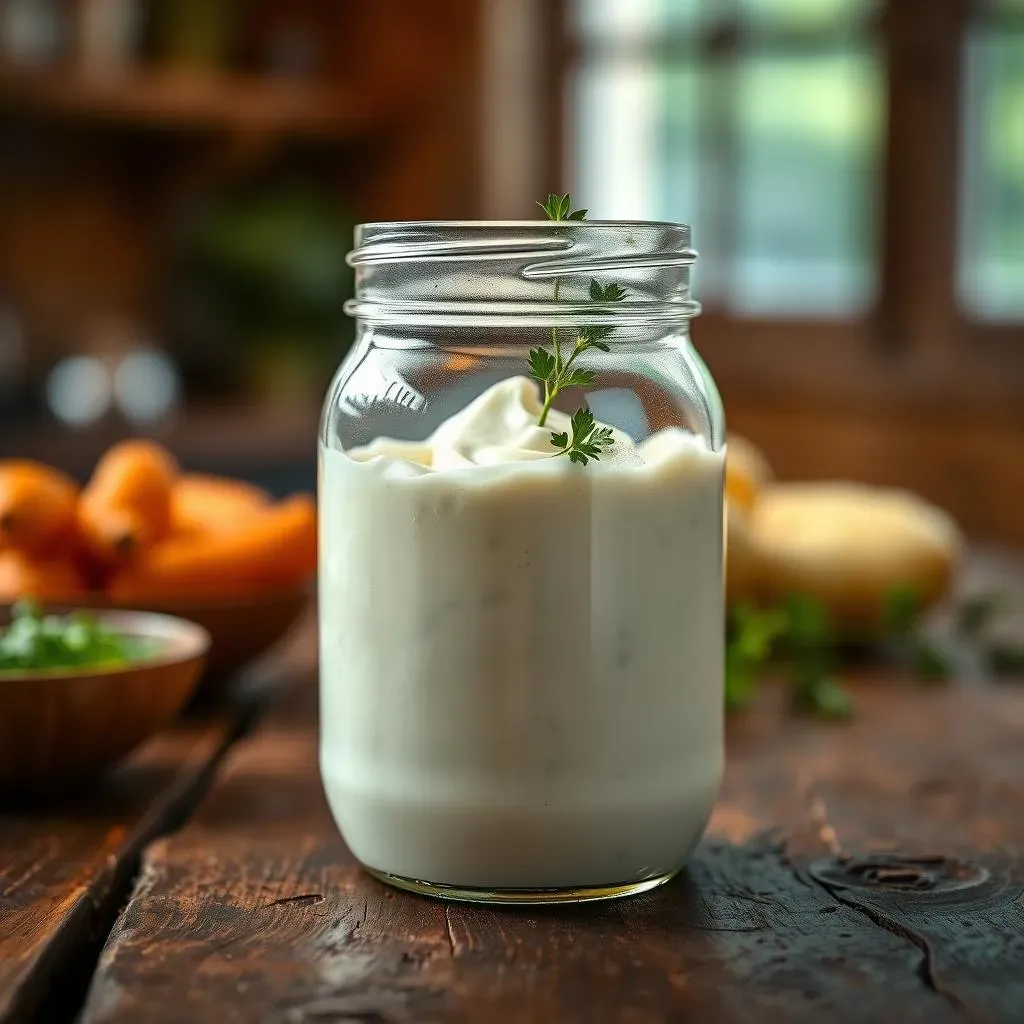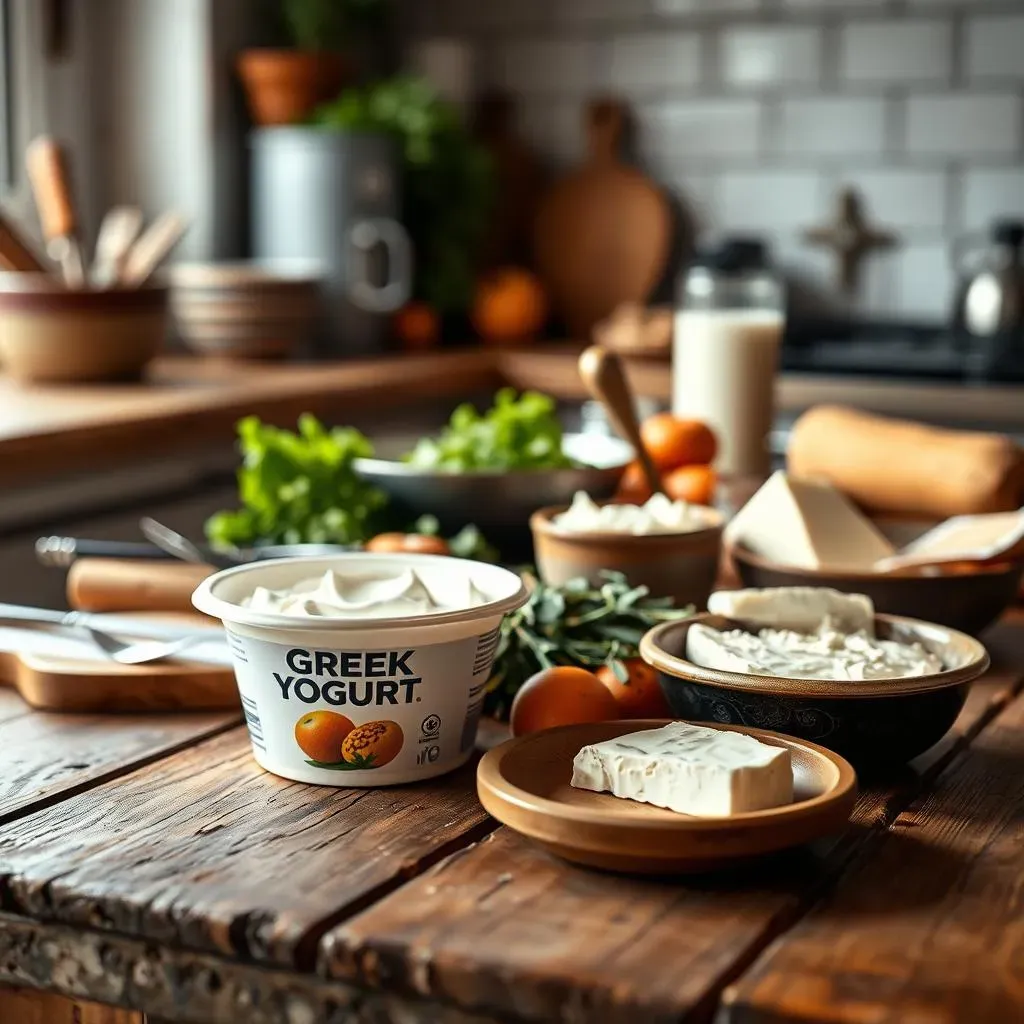Table of Contents
Ever found yourself mid-recipe, only to realize you're completely out of sour cream? It's happened to the best of us. That tangy, creamy dollop is a staple in so many dishes, from tacos to baked potatoes, and its absence can feel like a culinary crisis. But fear not, fellow food enthusiasts! This article is your guide to the best substitute for sour cream, ensuring that your cooking adventures don't hit a snag. We'll explore common and not-so-common alternatives, from the usual suspects like Greek yogurt and cream cheese, to some unexpected heroes like coconut milk and even mayo. We'll also talk about how to make your own sour cream at home if you’re feeling ambitious. By the end of this, you will have a toolkit of ideas that ensure your recipes will always be delicious, no matter what your fridge is lacking. Let’s get started and make sure you are prepared for any sour cream emergency!
What is Sour Cream?

What is Sour Cream?
The Tangy Truth About Sour Cream
Okay, so before we dive into all the amazing substitutes, let's talk about the star of the show: sour cream. I know, it sounds basic, but it's good to know what we're trying to replace, right? Simply put, sour cream is a dairy product made from fermenting regular cream. It's like milk's cool, slightly rebellious cousin. They add special bacteria to the cream, and these little guys munch on the lactose, creating lactic acid. This is what gives sour cream its signature tangy flavor and thick texture. It’s not just cream gone bad, it's cream that's been transformed into something uniquely delicious.
Think of it like this: you've got your regular cream, all sweet and innocent. Then, the bacteria come along like tiny party crashers, and suddenly, you have this thick, zesty concoction that's perfect for topping tacos or swirling into soups. It's a little bit of food science magic, if you ask me.
The Science of Sour
The fermentation process is key. It not only gives sour cream its flavor but also helps preserve it, which is pretty neat. This process thickens the cream, making it more stable and less likely to separate when heated. This is why it's such a champ in so many recipes. It can handle a bit of heat without turning into a watery mess. It’s also the reason why it’s so versatile, working in both sweet and savory dishes. You'll see it topping everything from enchiladas to desserts, and that's because of its unique flavor and texture.
Now, not all sour creams are created equal. You'll find different fat percentages, which affect the richness and thickness. The higher the fat, the creamier and more decadent it will be. So, if you're watching your fat intake, you might opt for a lower-fat version, but keep in mind it may not be quite as thick. It’s all about finding the right balance for your needs.
Component | Description |
|---|---|
Cream | The base ingredient, usually heavy cream. |
Lactic Acid Bacteria | Microorganisms that ferment the cream. |
Lactic Acid | The byproduct of fermentation, giving it the tangy flavor. |
Fat Content | Varies, affecting the thickness and richness. |
Sour Cream's Role in Cooking
I think the best part about sour cream is its versatility. It's not just a topping, it's also a fantastic ingredient in all kinds of cooking. It adds moisture to baked goods, making cakes and muffins super tender. It also adds a lovely tang to sauces, balancing out richer flavors. For example, if you're making a chili, a dollop of sour cream can cut through the spiciness and add a cooling sensation. It’s like a culinary chameleon, adapting to whatever you need it to be.
It also works wonders in dips and dressings, adding a creamy texture and a zesty kick. And let's be honest, who can resist a perfectly loaded baked potato with a generous dollop of sour cream? It’s a simple pleasure that we all deserve. So, understanding what sour cream is and how it works will help you understand why these substitutes work so well. And hey, if you can't find sour cream, you’ll now have this knowledge to guide you.
Easy Swaps for Sour Cream

Easy Swaps for Sour Cream
Greek Yogurt: The Tangy Twin
Alright, let's get to the good stuff – what to use when that sour cream container is sadly empty. First up, we have Greek yogurt. This stuff is like sour cream's healthier, slightly more athletic cousin. It has that same tangy flavor and creamy texture, making it a super easy 1:1 swap in most recipes. I mean, seriously, who hasn't grabbed a tub of Greek yogurt thinking it was sour cream? I have, more times than I'd like to admit. It's a great source of protein too, so you're getting an extra nutritional boost while still enjoying that creamy goodness. Just be mindful that some Greek yogurts can be a bit thicker than sour cream, so you might want to add a splash of milk or water to get it to the right consistency.
I've used Greek yogurt in everything from dips to baked goods, and honestly, most of the time, you can't even tell the difference. It’s one of those substitutes that just works, no fuss, no muss. Plus, it's usually pretty easy to find in any grocery store, so you're not going on a wild goose chase for some obscure ingredient. If you are looking for a quick and easy fix, Greek yogurt is your best friend. It's like having a secret weapon in your kitchen. Next time you are making a recipe just remember to give it a shot.
Cream Cheese: The Rich Substitute
Next on our list is cream cheese, the rich and decadent cousin of sour cream. Now, cream cheese is definitely thicker and richer, so it's not a straight 1:1 swap, but with a little bit of love, it works wonders. You'll want to soften it first (a quick zap in the microwave does the trick). Then, whisk in a bit of milk, water, or even lemon juice to thin it out and get it closer to the consistency of sour cream. I find that adding a touch of lemon juice also adds a bit of that sour tang we're looking for.
Cream cheese is fantastic in baked goods, where it adds moisture and a lovely richness. Think about it in a cheesecake or even in a batch of muffins. It also works really well in dips, but you might want to add some extra seasonings to balance out the flavor. It’s one of those ingredients that can easily sneak its way into different recipes, and no one would ever suspect that it’s not sour cream. Just remember to adjust the consistency and you’ll be good to go. It’s a versatile swap and always a good choice.
Substitute | Texture | Flavor | Best Use |
|---|---|---|---|
Greek Yogurt | Creamy, slightly thinner | Tangy | Dips, toppings, sauces, baking |
Cream Cheese | Thick, rich | Mild, slightly tangy | Baking, dips, sauces (with adjustments) |
Dairy and NonDairy Alternatives

Dairy and NonDairy Alternatives
Buttermilk, Kefir, and Crème Fraîche: The Dairy Delights
Okay, let's talk about some other dairy options that can step in for sour cream. First up is buttermilk, which is not actually as buttery as the name suggests. It's the liquid left over after making butter, and it has a lovely tangy flavor that's similar to sour cream. It's thinner, so it’s not a great topping, but it’s fantastic in baking, making your cakes and pancakes super fluffy and moist. Then there's kefir, a fermented milk drink that's packed with probiotics. It's tangier than sour cream, so you might want to start with a smaller amount and adjust to your taste. It’s a great option if you want to add a bit of gut-friendly goodness to your dish. And for something a bit more luxurious, there's crème fraîche. It’s richer and creamier than sour cream, with a slightly nutty flavor. It's amazing in sauces and soups, and you can boil it without worrying about it separating. It is a bit more indulgent, so it's perfect for when you want to treat yourself.
These dairy alternatives each bring their unique qualities to the table. Buttermilk is your go-to for baking, kefir is great for a tangy twist, and crème fraîche is perfect for adding richness. It’s like having a whole team of dairy superheroes at your disposal. Each one is unique in its own way, but all of them are fantastic substitutes for sour cream. Just keep in mind the texture and flavor differences, and you’ll be able to choose the best one for your recipe. It’s all about experimenting and seeing what works best for you.
Mayonnaise: The Unexpected Hero
Now, for a curveball: mayonnaise. Yes, that's right, mayo can actually be a sour cream substitute. It’s not the first thing that comes to mind, I know, but it can work in a pinch. Mayo is made with eggs and oil, so it has a richness that can mimic sour cream in certain recipes. However, it lacks the tang, so you'll want to add a splash of vinegar or lemon juice to get closer to that sour cream flavor. I've used it in baked goods, and it adds a lovely moisture, making them super tender. And when thinned out with vinegar, it can make a decent topping, though it's not exactly the same as sour cream. It’s a bit of a wild card, but sometimes you have to work with what you have. It's like that friend who always surprises you with their hidden talents.
It’s also good to use it as a binding agent, so if you are making a salad or a dressing, it can definitely do the trick. Just don’t go overboard with it, or your dish might end up tasting too much like mayo. It’s all about finding the right balance. If you are in a bind and need a quick alternative, mayo can be a lifesaver. It’s one of those unconventional substitutes that can really save the day. Just remember to adjust the flavor with some vinegar or lemon juice, and you’ll be good to go. It’s a very useful trick to have in your cooking arsenal.
Substitute | Texture | Flavor | Best Use |
|---|---|---|---|
Buttermilk | Thin, liquid | Tangy | Baking |
Kefir | Thick, drinkable | Very Tangy | Sauces, smoothies |
Crème Fraîche | Thick, creamy | Rich, nutty | Sauces, soups |
Mayonnaise | Thick, creamy | Rich, slightly tangy (with vinegar) | Baking, dressings |
Cottage Cheese and Coconut Milk: The Healthier and Dairy-Free Options
For those looking for healthier or dairy-free alternatives, we have cottage cheese and coconut milk. Cottage cheese is a great option if you want to boost the protein content of your dish. It's lower in fat than sour cream and has a mild, slightly tangy flavor. If you are looking for a smooth texture, blend it with a bit of milk and lemon juice. This will make it similar to the consistency of sour cream. It's a great choice for a healthier dollop on your tacos or baked potatoes. It’s also a good substitute in dips and dressings. It’s like a protein powerhouse in disguise.
And for those who need to avoid dairy, coconut milk is your best friend. It is super creamy, making it a great swap in sauces and soups. It does have a slight coconut flavor, so keep that in mind when you're using it, but it’s great in curries or anything with an Asian twist. You can also use coconut cream for an even richer texture. Both cottage cheese and coconut milk offer unique nutritional benefits while still providing the creaminess you need. It’s always good to have options, and these two are great for those with dietary restrictions or those wanting to try something different. It's like having a secret ingredient that can make your dish both delicious and nutritious.
- Cottage Cheese: High in protein, low in fat. Blend for a smooth texture.
- Coconut Milk: Dairy-free, creamy, and great for sauces and soups.